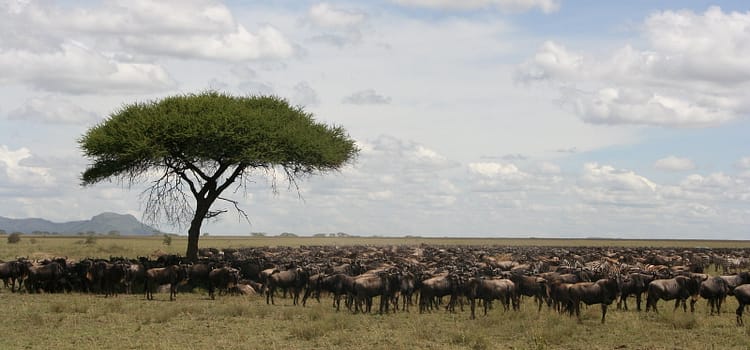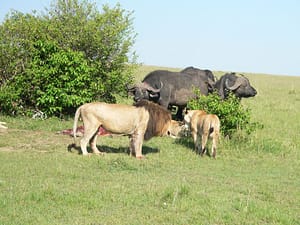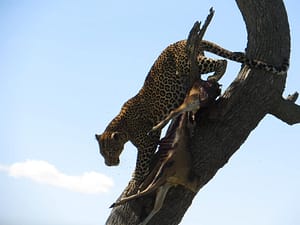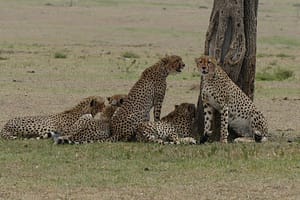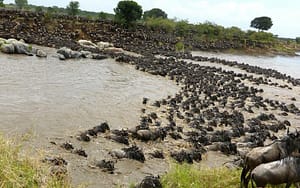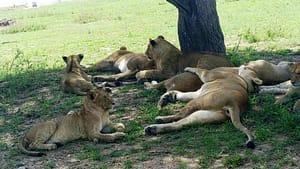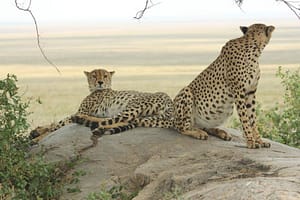SERENGETI OR MASAI MARA, WHICH IS BEST TO VISIT FOR SAFARI?
For many ardent wildlife safari lovers looking for an authentic African wildlife safari experience, the first destinations that come to mind are Kenya and Tanzania which are home to the leading national parks of Masai Mara and the Serengeti. For those planning to visit East Africa for the first time, the second question that comes to mind is which one to visit first between these two world renowned parks.
As destination experts who have traversed these two iconic wildlife reserves several times over many years, we are here to guide you into making an informed decision, by taking you through the finer details of each park.
But before we start describing these two amazing destinations, one thing worth mentioning is that both Masai Mara National Reserve and Serengeti National Park share the same eco system. In fact, they are part of each other, only divided by political boundaries.
Covering an area of 14,570 sq. km, the Serengeti, derives its name from the Maa language of the nomadic Masai who originally inhabited this land. “Siringet” means endless plains or the plains that tend to extend. The Masai who are the ancestral inhabitants of Serengeti came up with this word in reference to the vast and seemingly endless plains of this national park which is located in northern Tanzania.
On the other, the Masai Mara National Reserve which is located in south western Kenya derived its name from the same Masai tribesmen. This is the place that the Masai used to call the land with “mottled plains” in reference to Masai Mara’s vast plains whose habitat seems from a distance to be dotted with spotted circles of mainly Acacia trees, Savannah, Scrubs and cloud shadows that are synonymous with the Masai Mara. Although located in Kenya, the Masai Mara which covers an area of 1,510 sq. km is in fact an extension of the Serengeti to the north, with only the Mara River and political boundaries putting the two apart. Comparing the size of both parks, Masai Mara which is smaller and with a high wildlife to area ratio offers one advantage when it comes to ease of seeing the BIG CATS from close quarters. On a lucky day, it is not unusual to come across some if not all members of the big five within a 3 hours game drive.
Both the Masai Mara and Serengeti are home to prides of Lions, Herds of African Elephants and Buffalos, Towers of Masai Giraffes, Clans of spotted Hyenas, Dazzles of Zebras, Schools of Hippos, Troops of Baboons, Black Rhinos, Jackals, Foxes among others. The plains of both reserves are teeming with hundreds to thousands of antelopes; impalas, gazelles, topi, hartebeest, eland and yes, the wildebeests that consist of both the resident and migrant herds. Cheetahs, Leopards and even rare cats like Serval Cats and Caracals are also present in both parks.
Until to now, I know you might still be asking, “so do I first visit Masai Mara, Serengeti or both”?
Our answer is, if you have time and resources, visit both of them on a Kenya and Tanzania Safari that we can tailor make for you.
If you can’t manage to visit both at a go, you are still guaranteed an amazing safari viewing experience, mainly depending on the number of nights you spend, the location of your lodge or camp and your choice of safari operator. We mention the latter because it is always important to book your safari with a professional and seasoned company whose safari consultants understand the destinations immensely, and who will of course allocate you an excellent, knowledgeable guide and safari vehicle. When doing the final price comparison, often this company will not offer the cheapest quote, since cheap turns out to be expensive in some cases. They will however have a reasonable quote depending on your budget and choice of accommodation.
DESCRIPTION AND COMPARISION OF THE MASAI MARA AND SERENGETI
Based on our experience in travelling the length and breadth of the Serengeti for over 10 years, and traversing the Masai Mara – both the main reserve and Mara Triangle as well as the many private conservancies for over 15 years, let’s offer you a comparison of these two iconic parks that attract the highest number of tourists to East Africa. As I had mentioned before, they share the same grassland ecosystem and host the greatest wildlife spectacle on earth- The Wildebeest Migration.
You may have read and seen from several sources that the scenery offered by these two amazing areas is “Open Grassland”. To a large extent, this is true. However, it would only be 100% true that Masai Mara and Serengeti are savannah grasslands if compared to desert, jungle and mountains. However, those who have observed the two parks more keenly will agree that there is a huge variation when you consider the terrain, scenery and habitat of the Mara – Serengeti ecosystem.
Southern Serengeti extending all the way to the Ngorongoro Conservation area which also incorporates the Lake Ndutu area forms the largest, flattest, seemingly never-ending short grass plains. This is the area where the great herds of thousands of migrant wildebeests’ roam and also give birth (calving season), from December to March. This is the time of the year when the area enjoys an abundance of water and fresh, soft grass just after the short rains season from November to December.
However, a move slightly north sees the vegetation change to the breathtakingly beautiful sweeping plains found in Central and Eastern Serengeti. These predominantly long grass plains intersected by Rivers and dotted with Simba, Masai and Moru Kopjes (Granite Rocky Outcrops) from which the “Pride Rock” in the Lion King Movie drew inspiration are to many the epitome of The Serengeti Experience, a typical Serengeti that offers a feeling of beauty and abundant space.
A move further to western and northern Serengeti introduces you to a hillier area that offers a different landscape. Here, you will also observe significantly more woodland, although the wide-open plains remain within your vicinity as clearly evident in the Wogakuria Hills in northern Serengeti. At the foot of these stunning hills, you will find the Mara River cutting across the north western sector of the Serengeti in an area which provides a location where some of the best River Crossings that one is likely to witness take place.
Looking across the border is Kenya where you will find most of Masai Mara’s sweeping open plains located right inside the officially gazetted Masai Mara National reserve, which also includes the Mara Triangle in the reserve’s western Corridor. The Mara Triangle is basically the land found to the West of the Crocodile infested Mara River as it cuts its way southwards through the world-famous reserve. From here, the stunning Siria Escarpment offers a back drop, making the Masai Mara picture perfect.
Flanking the Mara River as it creates its path through the reserve is a dense forest, a swathe of green snaking through an otherwise open and seemingly “yellow” landscape.
If you move northwards on your way out of the main (official) reserve, you will end up in the privately managed wildlife conservancies that are more exclusive. Just so that we don’t confuse you, the conservancies are made up of land that the native Masai communities have handed over to private entities for conservation and tourism activities. They keep their livestock away from the land and in return get significant proceeds that are collected through tourism activities. Here, the terrain becomes more diverse. You will come across acacia woodland, rocky escarpments, plateaus, hidden valleys and multiple River courses. Here, the scenery can keep on changing as you move from the vast “Aitong Plains” area to different areas like the aptly named “Leopard Gorge”.
Found in abundance in all the various habitats that we have covered is a plethora of wildlife. One could say with confidence that there is no other part of the world that can boast to have the amount and species of wildlife that the Serengeti – Mara ecosystem hosts, especially if we focus more on land mammals. A huge number of herbivores like Thomson and Grants Gazelle is supported by the vast grassland ecosystem. Wildebeest, Zebra, Eland and Wildebeest which also form part of the great migration thrive here together with large numbers of Giraffes, Buffalos, Elephants, Hippopotamus, Hartebeest, Topi, Impala among others species. In the circle of life, prey is the main source of food for predators so you are guaranteed to come across Lions, Cheetahs, Leopards, Spotted Hyenas, marauding packs of Wild Dogs and the ferocious Crocodiles that inhabit the Mara and Grumeti Rivers.
This leads us to the most important question. Between the Masai Mara and Serengeti, which park could claim to have a better wildlife viewing experience than the other? This is for sure not an easy question to answer. In honesty and based on our years of travel between these two iconic parts, it would not be fair or even correct to say that one is better than the other. Looking through the finer details though, we can pick out a few points that can help you decide for yourself.
With the Serengeti being bigger in size (9 times the size of Masai Mara), and some parts of it having a lower concentration of wildlife than others, (eastern and northern Serengeti except the area neighboring the Mara River), one would favor Masai Mara. Besides being larger in size, the Serengeti which is a park has fewer driving tracks compared to Masai Mara which is a smaller reserve, with authorities having created more driving tracks. This gives the Mara an advantage in that the wildlife concentration is high, with more driving tracks also offering guests higher chances of getting up close with the Big Cats and other animals. It is not unusual to views Lions and Cheetahs in the Serengeti from hundreds of meters and even kilometers away.
The Serengeti also happens to be mote seasonal with the vegetation and game viewing experience changing quite dramatically during some months. Case in mind is the short grass plains of Southern Serengeti. These are usually dry and lacking in pasture and fresh water especially between July and October. The drier and harsher environment drives both prey and predator away, making the game viewing experience less exciting as it usually is between the wet and rainy green season of December to May.
Comparatively, The Masai Mara although also having different seasons, including the migration season from July to October still has plenty of resident game that does not migrate. Although the reserve also suffers from severe drought and harsh conditions just like the Serengeti, random rains do fall at any time of the year thus making the conditions fairer.
Moving away from the game viewing and the animals that you are likely to see; we now look at optional activities that enhance your safari experience. In both the Serengeti and Masai Mara (main reserve), your game drives are mainly restricted by authorities to between 0600 hrs and 1800 hrs. You are also restricted to well traversed driving paths which you have to stick to. In the Serengeti, there are very few places where walking safaris or night game drives are permitted. The case is however different in Masai Mara’s private wildlife conservancies. Here, you have an option for night game drives, walking safaris and even off-road driving. Although this is not offered at all the camps, it offers an enhanced wildlife experience to the discerning traveler. It is also worth noting that the private conservancies have fewer tourists, and the guides here adhere strictly to park regulations. Unlike the other parts of the reserve, here you can spend hours around a pride of Lions or a Cheetah family just by yourselves, or in the company of very few other safari jeeps.
When it comes to witnessing the wildebeest migration, the timing of your safari matters most, whether it is in the Masai Mara or Serengeti. With the Masai Mara, this happens between July and October, although herds have been recorded arriving in June and leaving in September. The last few years have also seen the herds return to Serengeti in late August, only to return to Masai Mara towards October, its all nature and instinct driven.
If you want to witness the migration in the Serengeti, it happens almost all year round. From December to April, you need to be in the south, May and June are the months it happens in Central and Western parts of the park. From July to November, the phenomenon takes place in the north around Bologonja and Kogatende crossing over to the Masai Mara.
If you are keen on seeing the River crossings, the months of July to October offer you the best chance. You can witness the migrating herds of wildebeests and Zebras make that “plunge of life or death” across the crocodile infested Mara River from either the Masai Mara or Serengeti, as well as smaller Rivers like the Talek River in Masai Mara and the Grumeti River in Serengeti. While Masai Mara has been known traditionally as the best place to see the River crossings, the opening up of the northern part of the Serengeti for camps to be built has seen the region steal some limelight from the Mara. Northern Serengeti has a good number of crossings points where one can camp waiting for the “out of this world show” to take place.
If you are after seeing predators, the Mara, with its several prides of Lions inhabiting a smaller area probably has an edge over the Serengeti. Cheetahs are known to favour open, flat grasslands from where they can monitor both prey and enemies. This would make Serengeti their favorite. However, the open plains all the way from Sopa area all the way to Talek and extending all the way to the conservancies are areas that abound with Cheetah population in the Masai Mara as well. These include the now popular “Tano Bora” or Fast Five coalition of marauding male cheetahs that have been traversing the vast Mara plains since year 2017. The two parks can therefore be considered great for Cheetah viewing.
A factor which is worth considering when looking at your game viewing options is the exclusivity and flexibility of your game viewing experience. Most tourists, especially photographers would wish for a scenario where you can take photos with few safari jeeps around, and with a possibility to drive closer to the wildlife. The private Mara conservancies do often offer that much cherished scenario. On the other hand, a sighting of a Leopard in the central Serengeti plains or a Cheetah in the sweeping southern plains is more likely to attract tens of safari jeeps. The same applies to the main Masai Mara Reserve. This is what makes the private Masai Mara conservancies a better location for your game viewing since the authorities are very strict on the number of safari vehicles that are permitted at a sighting. Often, you can end up savoring the views and taking photos all by yourself, or with only a few other tourists around. This is an important factor for many photographers.
The location of your camp and the area of the Masai Mara or Serengeti where you stay during your visit is another important factor. If not properly guided, you might end up staying at an area where it takes you hours of driving before for get to the prime game viewing areas. This mainly applies to the Serengeti since the Masai Mara has an advantage of having a slightly more condensed game viewing area. Some camps are however located outside the park gates and you can drive for an hour plus before you start seeing some major sightings. That is where a knowledgeable and honest tour operator like us comes in handy once again.
In terms of pricing, it generally costs you more to stay in the Serengeti compared to Masai Mara. Lodges and camps in Tanzania are pricier, and you still have to pay park entrance fees and concession fees on top of accommodation. On the other hand, Masai Mara is not necessarily cheap, but it offers you more accommodation options to choose from. This ranges from decent, budget tented camps that cost as low as around USD 160 per double room per night during the low season, to top luxury tented camps that cost over USD 2,000 per double room per night (including game drives) during the peak season. Unlike the Serengeti, in Masai Mara, you are only charged park entrance or conservancy fees. Both Serengeti and Masai Mara are simply magical and you will always find something unique in each. You can try out our 8 days Masai Mara and Serengeti Migration Safari and feel that witnessing the migration from each of the two regions offered its own unique experience. This is possible by road, and we now have options of flying all the way from the Masai Mara to Serengeti and vice versa, making it possible for you to enjoy your breakfast in one park, and lunch in the other, thus saving you hours of driving.
If the question on your mind right now is the number of nights you need to spend in any of these two parks, the advice that we would give based on time we have spent exploring these amazing destinations is minimum 3 nights in each. This ensures that you enjoy your game drives with no rush, and gives you time to search for some animals like Leopards and Rhinos that often proof elusive. Depending on the time and budget at your disposal, and your main interests during your safari, you may then spend up to 10 nights. This could probably be divided by half between the two fascinating destinations. We highly recommend the longer stays especially if you are a keen photographer, or if you are trailing the migration which can sometimes turn tricky especially when it comes to River crossings.
Normally, most visitors seeking to visit both Masai Mara and Serengeti have an interest in exploring other leading parks in Kenya and Tanzania. There are several options available, including our bestselling- 12 Days Kenya and Tanzania Highlights Safari which is by road, with optional flights between Masai Mara and Serengeti available.
Feel free to contact us for a free quote by a passionate and knowledgeable safari consultant.

